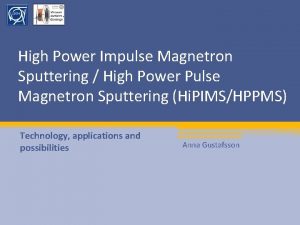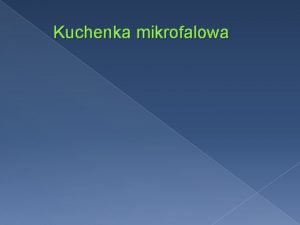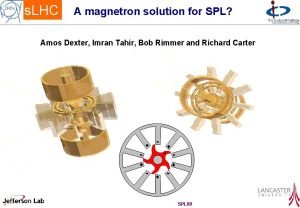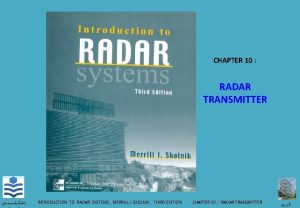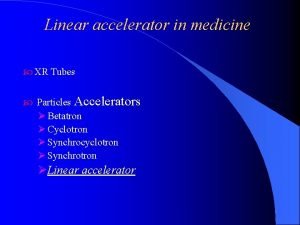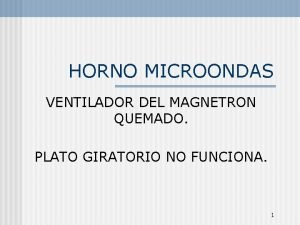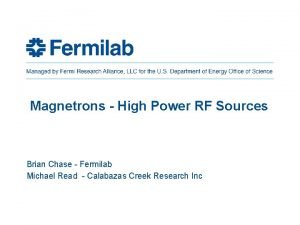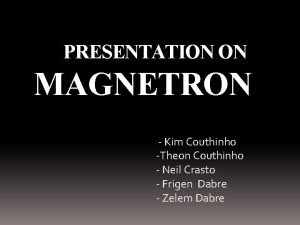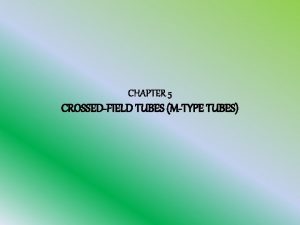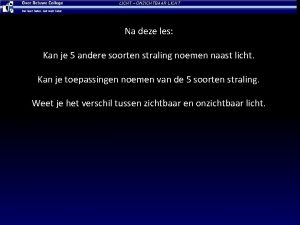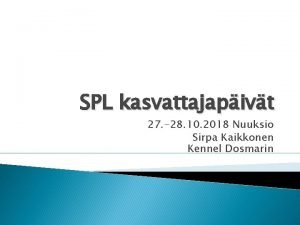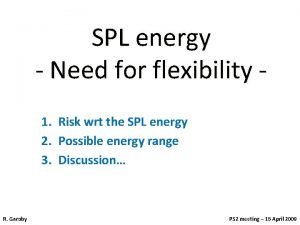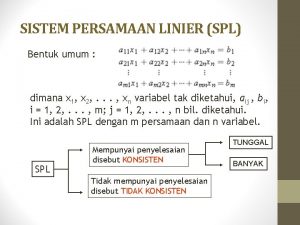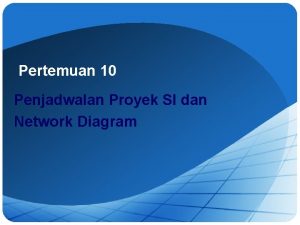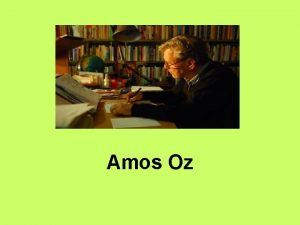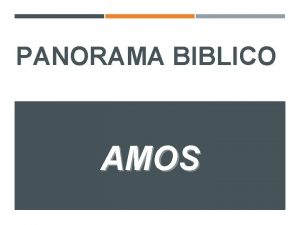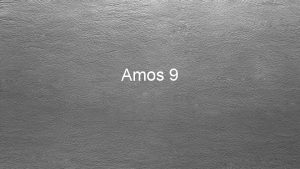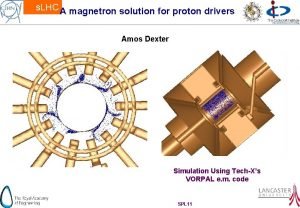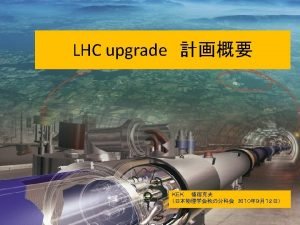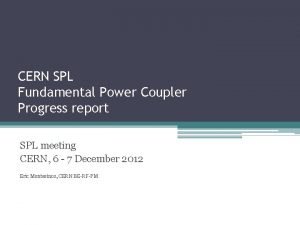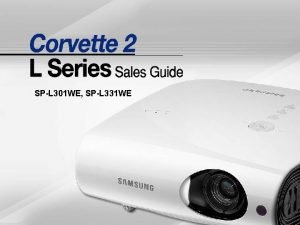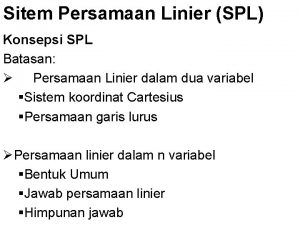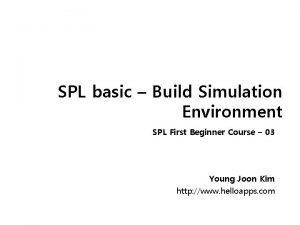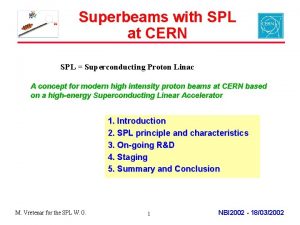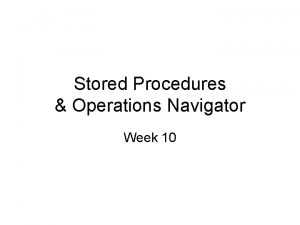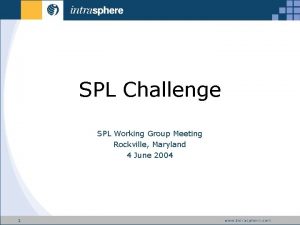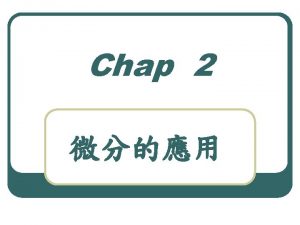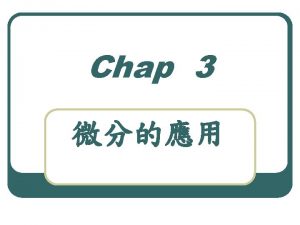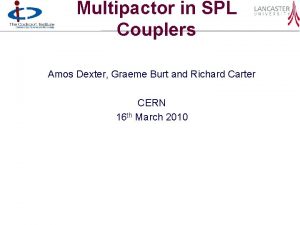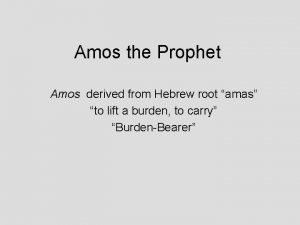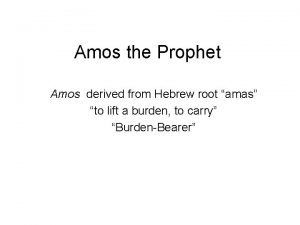s LHC A magnetron solution for SPL Amos





















- Slides: 21

s. LHC A magnetron solution for SPL? Amos Dexter, Imran Tahir, Bob Rimmer and Richard Carter SPL 09

s. LHC The Reflection Amplifier • Linacs require accurate phase control • Phase control requires an amplifier Cavity • Magnetrons can be operated as reflection amplifiers Compared to Klystrons, in general Magnetrons Magnetron Load Circulator Injection Source - are smaller - more efficient - can use permanent magnets (at 704 MHz) - utilise lower d. c. voltage but higher current - are easier to manufacture Consequently they are much cheaper to purchase and operate J. Kline “The magnetron as a negative-resistance amplifier, ” IRE Transactions on Electron Devices, vol. ED-8, Nov 1961 H. L. Thal and R. G. Lock, “Locking of magnetrons by an injected r. f. signal”, IEEE Trans. MTT, vol. 13, 1965 SPL 09

s. LHC Reflection Amplifier Controllability 1. Phase of output follows the phase of the input signal 2. 3. Phase shift through magnetron depends on difference between input frequency and the magnetrons natural frequency Output power has minimal dependence on input signal power 4. Phase shift through magnetron depends on input signal power 5. There is a time constant associated with the output phase following the input phase Anode Voltage 915 MHz 10 k. W 20 k. W 916 MHz 30 k. W 40 k. W 12. 0 k. V 3. 00 A 11. 5 k. V 2. 92 A Magnetron frequency and output vary together as a consequence of 1. Varying the magnetic field 2. Varying the anode current (pushing) 3. Varying the reflected power (pulling) 0 o Arcing Power supply load 11. 0 k. V line 2. 85 A 900 W 800 W 700 W 2. 78 A 10. 5 k. V 2 270 o 2. 70 A 10. 0 k. V 1 towards magnetron Moding 2 3 4 5 Magnetic field coil current VSWR 3 4 6 90 o +5 MHz +2. 5 MHz -5 MHz Anode Current Amps -2. 5 MHz SPL 09 180 o +0 MHz

s. LHC Magnetrons for Accelerators Single magnetrons 2. 856 GHz, 5 MW, 3 ms pulse, 200 Hz repetition are used to power linacs for medical and security applications. Multiple magnetrons have been considered for high energy normal conducting linacs but the injection power needed for an unstabilised magnetron made it uncompetitive with a Klystron. Overett, T. ; Bowles, E. ; Remsen, D. B. ; Smith, R. E. , III; Thomas, G. E. “ Phase Locked Magnetrons as Accelerator RF Sources” PAC 1987 Benford J. , Sze H. , Woo W. , Smith R. , and Harteneck B. , “Phase locking of relativistic magnetrons” Phys. Rev. Lett. , vol. 62, no. 4, pp. 969, 1989. Treado T. A. , Hansen T. A. , and Jenkins D. J. “Power-combining and injection locking magnetrons for accelerator applications, ” Proc IEEE Particle Accelerator Conf. , San Francisco, CA 1991. Chen, S. C. ; Bekefi, G. ; Temkin, R. J. “ Injection Locking of a Long-Pulse Relativistic Magnetron” PAC 1991 Treado, T. A. ; Brown, P. D. ; Hansen, T. A. ; Aiguier, D. J. “ Phase locking of two longpulse, high-power magnetrons” , IEEE Trans. Plasma Science, vol 22, p 616 -625, 1994 Treado, Todd A. ; Brown, Paul D. , Aiguier, Darrell “New experimental results at long pulse and high repetition rate, from Varian's phase-locked magnetron array program” Proceedings Intense Microwave Pulses, SPIE vol. 1872, July 1993 SPL 09 Courtesy of e 2 v

s. LHC J. C. Slater Adler’s Equation for Injection Locking “The Phasing of Magnetrons” MIT Technical Report 35, 1947 Shien Chi Chen “Growth and frequency Pushing effects in Relativistic Magnetron Phase – Locking”, IEEE Trans. on Plasma Science Vol. 18 No 3. June 1990. The basic circuit model for the phased locked magnetron is the same as for a cavity Injection Negative impedance to represent magnetron spokes excitation of -ZS the anode. Includes static pushing effects. L R C Zw To get Adler’s equation set to give SPL 09 Load impedance includes pulling effects.

s. LHC Solution of Adler’s Equation Like wo winj y Vinj /RF magnetron ang. oscillation frequency without injection for small y hence phase stabilises to a constant offset injection angular frequency phase shift between injection input and magnetron output equivalent circuit voltage for injection signal / RF output Adler’s equation predicts that : if wo = wi then y → 0 if wo close to wi then y → a fixed value (i. e. when sin y < 1 then locking occurs) if wo far from wi then y → no locking unless Vinj is large Steady state If the natural frequency of the magnetron is fluctuating then the phase y will be fluctuating. High frequency phase jitter will be filtered by a superconducting the cavity Advancing or retarding the injection signal allows low frequency jitter to be cancelled and the magnetron phase or the cavity phase to be maintained with respect to a reference signal. SPL 09

s. LHC Power Needed for Injection Locking The minimum locking power is given when sin y = 1 PRF is output power QL refers to the loaded magnetron. Pushing For our 2. 45 GHz cooker magnetron (fi –fo) due to ripple ~ 2 MHz (fi –fo) due to temperature fluctuation > 5 MHz This is big hence must reduce fi – fo ( can do this dynamically using the pushing curve) Time response ~ ~ 400 ns ~ 1000 RF cycles SPL 09

s. LHC Amplifier Requirement to Drive S. C. Cavity A full system model assists in understanding amplifier requirement input waveguide impedance transformer forward wave amplitude = F L 1 C 1 R 1 waveguide impedence = Zext L 2 C 2 R 2 equivalent electrical circuit for excitation of two cavity modes resulting differential equation for N modes ( Numerically solve envelope equations ) conversion from circuit parameters to cavity parameters • Microphonics cause wi to vary with time • Beamloading causes V to jump when a bunch passes through • The amplitude and phase of F depend on the controller, the amplifier characteristics and the coupler temperature SPL 09

s. LHC Amplifier action for SPL cavity - case 1 Plausible parameters • Fill at almost full power • PI control plus simple feed forward when pulse arrives • Drive power and drive phase depends on cavity frequency offset caused by microphonics and Lorentz detuning SPL 09 Drive frequency in GHz = 0. 704 GHz Centre cavity frequency in GHz = 0. 704 GHz Number of cavity modes included = 1 Cavity Q factor = 1. 0 E+09 External Q factor = 4. 0 E+06 Cavity R over Q = 100 ohms Energy set point = 21. 8 J Amplitude set point = 4. 8792 MV Max Amplifier Power per cell = 59 k. W Max voltage set point (no beam) = 13. 740 MV Target fill time = 9. 0 E 04 s Cycle number for beam arrival = 568000 Maximum bunch phase jitter = 0. 000 deg Bunch charge (ILC=3. 2 n. C) = 0. 057 n. C RF cycles between bunches = 2. 0 Bunch train length = 1. 2 ms Cavity frequency shift from microphonics = 60 Hz Cavity vibration frequency = 200 Hz Phase measurement error(degrees) = 0. 000 deg Fractional err in amplitude measurement = 0. 0000 Time delay (latency) for control system = 1. 0 E

s. LHC Phase and amplitude control – case 1 In pulse rms phase err = 0. 01909 deg In pulse rms amplitude err = 0. 02998 % SPL 09 Filling at almost full power may give poor phase accuracy at start of bunch train

s. LHC Amplifier action for SPL cavity - case 2 • Reduce fill rate as cavity approaches set point, the control system can then fix the phase error. • PI control plus simple feed forward when pulse arrives SPL 09 Plausible parameters Drive frequency in GHz = 0. 704 GHz Centre cavity frequency in GHz = 0. 704 GHz Number of cavity modes included = 1 Cavity Q factor = 1. 0 E+09 External Q factor = 4. 0 E+06 Cavity R over Q = 100 ohms Energy set point = 21. 8 J Amplitude set point = 4. 8792 MV Max Amplifier Power per cell = 59 k. W Max voltage set point (no beam) = 13. 740 MV Target fill time = 10. 0 E 04 s Cycle number for beam arrival = 750000 Maximum bunch phase jitter = 0. 000 deg Bunch charge (ILC=3. 2 n. C) = 0. 057 n. C RF cycles between bunches = 2. 0 Bunch train length = 1. 2 ms Cavity frequency shift from microphonics = 60 Hz Cavity vibration frequency = 200 Hz Phase measurement error(degrees) = 0. 000 deg Fractional err in amplitude measurement = 0. 0000 Time delay (latency) for control system = 1. 0 E -06 s

s. LHC Phase and amplitude control – case 2 Phase correct at start of bunch train In pulse rms phase err = 0. 01953 deg In pulse rms amplitude err = 0. 00854 % SPL 09 Note that microphonics start with same phase as before but as the bunch arrives later the cavity frequency offset is greater and the resultant phase error is greater despite the better start.

s. LHC Layout using one magnetron per cavity Permits fast phase control but only slow, full range amplitude control A substantial development program would be required for a 704 MHz, 880 k. W long pulse magnetron Standard Modulator Pulse to pulse amplitude can be varied Cavity 880 k. W Magnetron Slow tuner ~ -13 d. B to -17 d. B needed for locking i. e. between 18 k. W and 44 k. W hence between 42 k. W and 16 k. W available for fast amplitude control Load 4 Port Circulator LLRF 60 k. W IOT Could fill cavity with IOT then pulse magnetron when beam arrives SPL 09

s. LHC Layout using two magnetrons per cavity Phasor diagram output of magnetron 1 Permits fast full range phase and amplitude control output of magnetron 2 Cavity combiner / magic tee Advanced Modulator Fast magnetron tune by varying output current 440 k. W Load Magnetron 440 W ~ -30 d. B needed for locking Magnetron 440 W LLRF 440 k. W Magnetron design is less demanding than 880 k. W design reducing cost per k. W, and increasing lifetime and reliability. SPL 09 Advanced Modulator Fast magnetron tune by varying output current

s. LHC water cooling for anode Magnetron Size air cooling for cathode dg dm hm air cooling input for dome SPL 09 915 MHz 704 MHz dg 325 mm ~ 425 mm dm 125 mm ~ 165 mm hm 500 mm ~ 650 mm € tube € 8000 ? If magnetron design is similar to industrial design with similar tolerances and can be made on same production line then cost may not be much more

s. LHC Cost Calculation 20 m. A beam SPL 09

s. LHC Notes for cost calculation SPL 09

s. LHC Cost Calculation for 40 m. A beam SPL 09

s. LHC Experiments at Lancaster Double Balance Mixer Oscilloscope 2 Stub Tuner 2 Water Load 1 W Amplifier Loop Coupler C 3 Circulator 1 3 Stub Tuner 1 Circulator 2 Water Load Loop Coupler 10 Vane Magnetron Load IQ Modulator (Amplitude & phase shifter) D/A A/D Power supply ripple Oscilloscope D/A DSP Digital Phase Detector 1. 3 GHz D/A ÷M Magnetron phase no LLRF LP Filter 8 k. Hz cut-off ÷M pk-pk 26 o High Voltage Transformer Frequency Divider / N Divider /R Micro. Controller 10 MHz TCXO 1 ppm 2. 3 - 2. 6 GHz PLL Oscillator ADF 4113 + VCO 40 k. Hz Chopper Magnetron phase with LLRF Pulse Width Modulator SG 2525 1. 5 k. W Power Supply Phase - Freq Detector & Charge Pump ADF 4113 Loop Filter 325 V DC + 5% 100 Hz ripple SPL 09 pk-pk 1. 2 o

s. LHC Experiments at Lancaster Tahir I. , Dexter A. C and Carter R. G. “Noise Performance of Frequency and Phase Locked CW Magnetrons operated as current controlled oscillators”, IEEE Trans. Elec. Dev, vol 52, no 9, 2005, pp 2096 -2130 Phase shift keying the magnetron Tahir I. , Dexter A. C and Carter R. G. , “Frequency and Phase Modulation Performance on an Injection-Locked CW Magnetron”, IEEE Trans. Elec. Dev, vol. 53, no 7, 2006, pp 1721 -1729 0 d. Bm RBW = 100 Hz Span = 100 k. Hz Centre = 2. 44998488 GHz Locked spectral output -50 d. Bm -100 d. Bm -50 k. Hz +50 k. Hz SPL 09 Lancaster has successfully demonstrated the injection locking of a cooker magnetron with as little as -40 d. B injection power by fine control the anode current to compensate shifts in the natural frequency of the magnetron.

s. LHC • • Way Forward Commission the development of a 704 MHz Magnetron (440 k. W) Procure standard modulator Set up test station with IOT as drive amplifier Understand locking characteristics of new magnetron Commission advanced modulator with in-pulse current control Establish minimum locking power Establish two magnetron test stand Develop LLRF for simultaneous phase and amplitude control Demonstration of CW 2. 45 GHz magnetron driving a specially manufactured superconducting cavity at JLab due later this month should stimulate more interest. SPL 09
 Edomah
Edomah Magnetron sputtering
Magnetron sputtering Magnetron niebezpieczeństwo
Magnetron niebezpieczeństwo Magnetron amplifier
Magnetron amplifier Radar transmitter
Radar transmitter Flatining
Flatining Magnetron quemado
Magnetron quemado Industry cw magnetron
Industry cw magnetron Magnetron construction
Magnetron construction M type microwave tubes
M type microwave tubes Magnetron omrekenen
Magnetron omrekenen Phún xạ magnetron
Phún xạ magnetron Magnetron funzionamento
Magnetron funzionamento Obsah trojbokého hranolu
Obsah trojbokého hranolu Obsah kužele
Obsah kužele Jalostusnetti
Jalostusnetti Spl energy
Spl energy Bentuk umum spl
Bentuk umum spl Objem kuželu
Objem kuželu Spl dalam bentuk matriks
Spl dalam bentuk matriks Penyajian spl
Penyajian spl Spl proyek adalah
Spl proyek adalah

